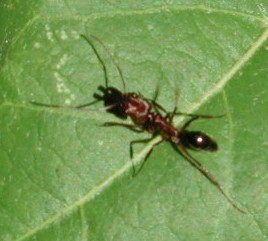Bear-trap Ant
Odontomachus clarus

This ant was photographed using a Nikon CoolPix 990 on 24 Oct. 2002 in Phoenix, Arizona. In the shadow cast by the ant - to left of head - the mandibles can be seen. In this case they are projecting forward ... usually they are kept wide open while the ant is hunting.
Formicidae -- Ant Family
These ants prefer moist habitat conditions which are rare in the Sonoran Desert. Mostly they are restricted to man-made, irrigated systems and riparian habitats.
Also known as trap-jaw ants, they hunt by walking slowly in an area where prey are present with their mandible-jaws wide open on a tight spring mechanism. If the palps (sensitive mouthparts), trigger hairs, or antennae sense a movement or contact the mandibles snap shut with incredible speed and power, piercing the prey. A tiny piece of grass can be used by an observer to trip this mechanism; the surprise is that an audible sound is made by the snapping mandibles! When temperatures are cool (< 17°C) this hunting method allows Odontomachus to operate when many ant species are incapacitated by the chill.
More Information:
- Tightloop.com - fantastic photos
- Bugguide.net Univ. of Iowa
- Google Images
- Google Scholar Literature Search